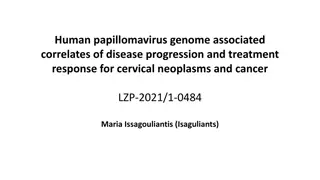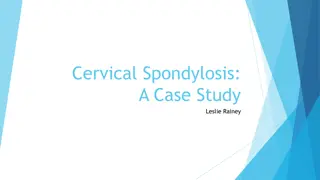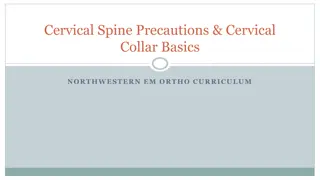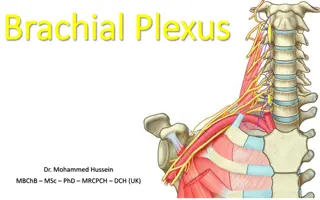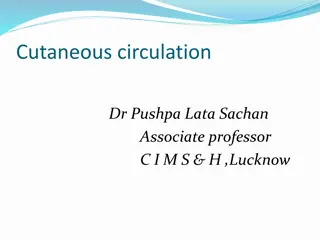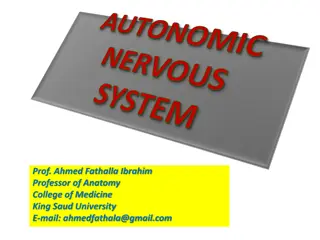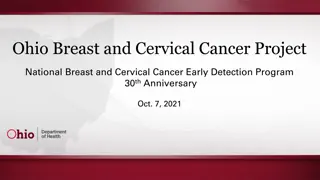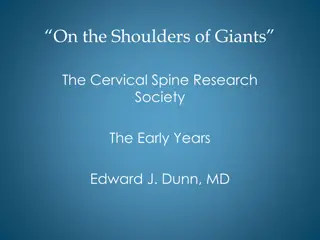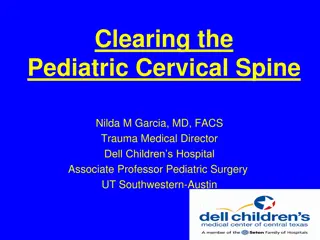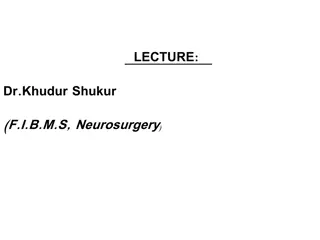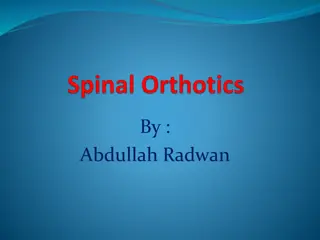Understanding the Cervical Part of Sympathetic Trunks
The sympathetic trunks play a crucial role in the human body, with the cervical part located in front of the transverse processes of cervical vertebrae and the neck of the 1st rib. This part presents three ganglia - superior, middle, and inferior. Sometimes, the inferior cervical and first thoracic ganglia fuse to form a cervico-thoracic or stellate ganglion. The number of cervical sympathetic ganglia corresponds to the spinal nerves, with fusion occurring to form the superior, middle, and inferior cervical ganglia. The cervical part of the trunk receives post-ganglionic fibers to each of the 8th cervical spinal nerves.
Download Presentation

Please find below an Image/Link to download the presentation.
The content on the website is provided AS IS for your information and personal use only. It may not be sold, licensed, or shared on other websites without obtaining consent from the author. Download presentation by click this link. If you encounter any issues during the download, it is possible that the publisher has removed the file from their server.
E N D
Presentation Transcript
Cervical Part of Sympathetic Trunks Presented by :- Dr. Sushma Tomar Associate Professor Department of Anatomy
Introduction There are tw o sym pathetic trunks (right & left) in hum an body. L ocation- E ach sym pathetic trunk is paravertebral in position. E ach sym pathetic trunk extends from the base of skull to the first coccygeal vertebra (base of coccyx).
Introduction contd A t the base of coccyx, both sym pathetic trunks join to form G anglion Im par.
Sym pathetic Trunks In The N eck L ocation- C ervical part of sym pathetic trunk lies in front of transverse processes of cervical vertebrae and neck of 1st rib. E ach sym pathetic trunk presents 3 ganglia in the cervical part:- Superior. M iddle. Inferior.
Sym pathetic Trunks In The N eck contd Som etim es, inferior cervical and first thoracic sym pathetic ganglion are fused to form a cervico-thoracic or stellate ganglion.
Sym pathetic Trunks In The N eck contd Initially the num ber of cervical sym pathetic ganglia corresponds w ith the num ber of spinal nerves. L ater, upper 4 cervical ganglia fuse to form superior cervical ganglion. 5th & 6th cervical ganglia fuse to form m iddle cervical ganglion. 7th & 8th cervical ganglia fuse to form inferior cervical ganglion.
C ervical P art Of Sym pathetic Trunk C ontd C ervical part of the trunk does not receive pre-ganglionic fibres through w hite ram i com m unicantes from the cervical segm ents of the spinal cord. E ach cervical sym pathetic trunk gives post-ganglionic fibres via grey ram i com m unicantes to each of the 8th cervical spinal nerves.
C ervical P art Of Sym pathetic Trunk C ontd A ll pre-ganglionic fibres for the cervical sym pathetic trunk are derived from lateral horn cells of T1-T5 segm ents of spinal cord. These preganglionic fibres ascend through the trunk and finally relayed in 3 cervical sym pathetic ganglia.
Superior C ervical G anglion L argest of the cervical sym pathetic ganglia. Form ed by the fusion of upper 4 cervical sym pathetic ganglia. SH A PE - Fusiform (spindle). L E N G TH - ~2.5 cm . L OC A TION - In front of transverse processes of C 2 & C 3 vertebrae.
Superior C ervical G anglion It receives pre-ganglionic fibres m ostly from upper 3 thoracic segm ents of spinal cord.
B ranches Of Superior C ervical G anglion D ivided into follow ing groups:- L ateral. M edial. A nterior. A scending. A ll branches convey post- ganglionic fibres and som e sensory fibres from the target organs.
L ateral B ranches Of Superior C ervical G anglion These are grey ram i com m unicans to upper 4 cervical nerves.
M edial B ranches Of Superior C ervical G anglion L aryngo-pharyngeal branches. C ardiac branch. L aryngo-pharyngeal branches- Supply C arotid body. Form pharyngeal plexus w ith 9th & 10th nerves. C ardiac branch- R ight cardiac branch joins w ith the deep cardiac plexus. L eft cardiac branch joins w ith the superficial cardiac plexus.
A nterior B ranches Of Superior C ervical G anglion These ram ify around com m on carotid aretry, external carotid artery and its branches. Sym pathetic plexus around facial artery gives a filam ent to the subm andibular ganglion. Sym pathetic plexus around m iddle m eningeal artery gives a filam ent to the otic ganglion and another filam ent to the genicular ganglion of facial nerve as external petrosal nerve.
A scending B ranches Of Superior C ervical G anglion Internal C arotid N erve. B ranches of Sym pathetic Plexus around Internal Carotid A rtery- C arotido-tym panic nerves. D eep petrosal nerve. N ervus conarii- supply pineal gland. C om m unicating branches- to trigem inal ganglion, 3rd , 4th , 5th & 6th cranial nerves. Term inal branches- supply the piam ater and tarsal m uscles.
M iddle C ervical G anglion Form ed by the fusion of 5th & 6th cervical sym pathetic ganglia. L OC A TION - In front of transverse process of 6th cervical vertebra. Just above the loop of inferior thyroid artery .
M iddle C ervical G anglion C ontd C OM M U N IC A TION S- C onnected w ith inferior cervical ganglion by ansa subclavia. A nsa subclavia loops in front and below the first part of subclavian artery.
B ranches Of M iddle C ervical G anglion L ateral. M edial. L ateral branches- These are grey ram i com m inicans to 5th & 6th spinal nerves. M edial branches- Thyroid branches. C ardiac branches.
Inferior C ervical G anglion Form ed by the fusion of 7th & 8th cervical ganglia. L OC A TION - B etw een transverse process of C 7 vertebra and neck of 1st rib.
Inferior C ervical G anglion C ontd Som etim es this ganglion joins w ith the first thoracic sym pathetic ganglion to form cervico-thoracic or stellate ganglion.
B ranches Of Inferior C ervical G anglion G rey ram i com m unicans. C ardiac branches. V ascular branches. G rey R am i C om m unicans- To C 7 & C 8 cervical spinal nerves. V ascular B ranches- Form plexuses around subclavian artery, 1st part of axillary artery and vertebral artery.
A pplied A natom y H ORN E R S SYN D ROM E - A lesion affecting the pre-ganglionic fibres from T1 & T2 segm ents of spinal cord. C linical Features- C onstriction of pupil (m iosis). D rooping of upper eyelid (ptosis). E nophthalm os. A bsence of sw eating on affected half of face and head (anhydrosis). L oss of ciliospinal reflex.








